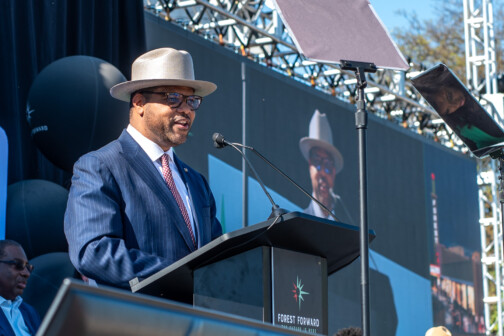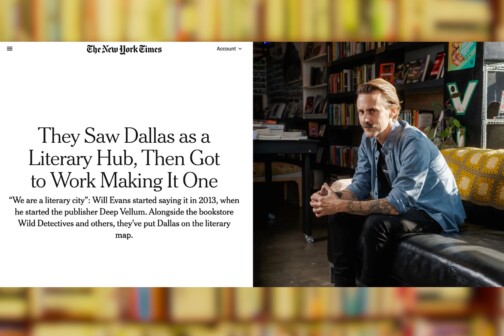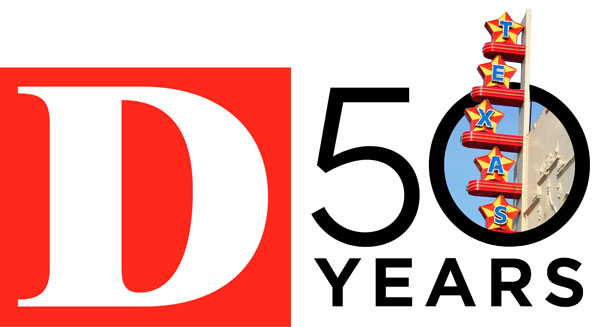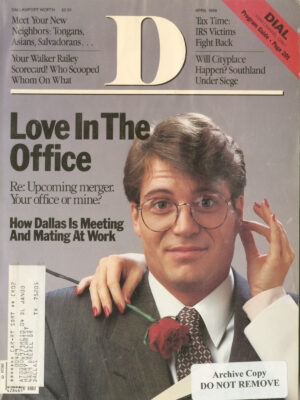There is a new wealth emerging in the Dallas/Fort Worth area-a growing high-technology capability that ultimately will change the fortunes and directions of business and industry as we know it.
At the heart of this promising reality is an educational institution that has been in our midst for nearly 100 years-The University of Texas at Arlington.
Subtly c hanging and shaping itself in systematic response to the signals of society, the Dallas/Fort Worth area’s largest center for higher learning is meeting the future now.
Today, UTA’s some 23,000 students-studying across the 350-acre campus just 25 minutes west of Dallas-are forging an unparalleled path, not just in the realm of high technology but also in the education of the whole person. Education at this university is about life as well as work.
What follows now is a story about partnership-a symbiotic relationship between the nation’s seventh largest population center and a powerful university-that figures prominently in the success of this region.
Preparing the Whole Person
Brain power. No matter how far artificial intelligence and robotics research expand our horizons of achievement, the pool of human talent will remain a life-giving force to any society. To that end, The University of Texas at Arlington has beer designed to meet the responsibility of educating the whole person.
In truth, UTA is most readily known for its Colleges of Engineering and Business Administration. It is rapidly expanding the reputations of its relatively new School of Architecture and Environmental Design and its School of Nursing. Yet nowhere can you turn on campus Without uncovering notable achievement in diverse academic areas. A quick survey would include:
▲ Learning to write effectively, analyze what is read, and to integrate information through critical thinking are the goats of CACTIP-an interdisciplinary program in Composition, Analysis of Text, Critical Thinking and Integrated Programs which is required of every undergraduate student at UTA. Cited by Secretary of Education William Bennett as “what schools ought to be doing,” CACTIP is the only program of its kind in Texas. It was begun four years ago with a $500,000 grant from the National Endowment for the Humanities.
▲ In information systems, UTA’s College of Business Administration is making international impact on the application of artificial intelligence research to computer systems that more precisely accomplish the automation of data handling. Led by Dr. Lawrence Schkade, Ashbel Smith Professor of information systems and management sciences, “expert systems” are being developed to assist physicians in better informed delivery of health care. Additionally, Schkade and his team of graduate students are developing worldwide information systems networks for multinational corporations that recognize cultural differences between decision makers as they adapt to data from the diverse enviroments in which they work.
▲ UTA’s Center for Energy Conversion Research has earned special distinction this year in two federal high-technology projects. In late 1987 UTA faculty and graduate students designed, fabricated and tested all high-voltage hardware external to the payload aboard the SPEAR I {Space Experiments Aboard Rockets) experiment Part of the nation’s Strategic Defense Initiative, the SPEAR I project has been nominated for Project of the Year honors following praise by Secretary of Defense Frank Carlucci.
A second project of note is UTA’s involvement in the creation of a proprietary impulse radar system for Norfolk Ship Systems. Funded by a contract from the U.S. Navy, the new-system has distinct defense advantages over conventional single-frequency radar. “UTA is currently the only entity in the United States with expertise in photoconducting switching and laser systems required to make the new radar possible,” reports Dr. W.C. Nunnally, director of the Center for Energy Conversion Research. “When brought to fruition, this technology can revolutionize the way in which radar systems are used in the Navy and the services in general,”
▲ New information about formerly unknown languages throughout the world is being discovered by UTA linguistics professor and Nobel Prize nominee Kenneth Pike and his colleague, Dr. Robert Longacre. These discoveries, and subsequent translations into English, are filling information gaps about cultural development in various regions of the world.
▲ Big Eight accounting firms surveyed during 1988 in the Dallas/Fort Worth area cite UTA as the preferred provider of accounting professionals. “We have a very high regard for the accounting program at UTA,” reports Bill Schilling, managing partner of Peat Marwick Main & Co. “It’s one of our most important sources of accounting graduates for both our Dallas and Fort Worth offices.”
From high technology to esoteric arts, The University of Texas at Arlington is forging a clear path of accomplishment in preparing the Dallas area for a significant role in the world’s future.
During the current year, UTA will receive private sector support in excess of $13 million. This comes in the form of gifts, grants and contracts from business and industry, and does not take into consideration the nearly $8 million in government funding which UTA receives from state and federal agencies.
Academic Choices to Fulfill a Lifetime
University studies are not just about preparing to earn a living. And, while UTA is unquestionably a leader in applied studies-offering academic degrees that have direct bearing on achievement in the marketplace, the University balances its offerings for the good of the whole person.
An examination of the student body at UTA would reveal a profile that looks like this:
▲ Nearly 20,000 students seeking undergraduate degrees; 3,500 studying for master’s and doctoral degrees.
▲ The average age of the UTA student of the late 1980s rests at age 25-with three-fourths of the student body falling into traditional age categories, and the remaining one-fourth classified as “older, returning students,” ▲ Twelve thousand UTA students live in Arlington and, of this number, as many as 2,000 live on campus in economical university housing for single and married students.
▲ UTA classes are scheduled from 8 a.m. until 10 p.m., Monday through Friday. Some 15,000 students attend classes during the day, while another 8,000 attend only at night or in some combination of day and night classes.
▲ Most of UTA’s students are Texas residents. Fewer than 1,000 come from out of state, and 1,100 come from abroad.
▲ For Texas residents, a year at UTA costs an estimated $790 in tuition and fees, and $3,600 for housing and living expenses.
▲ Most UTA students are enrolled in four of the University’s nine academic units. The largest concentration is in the College of Business Administration (some 7,000). Liberal Arts attracts some 6,000, while Engineering claims more than 4,000 and Science, 3,000.
Educators/Researchers of International Renown
As University President Dr. Wendell H. Nedderman explains, “There are three common threads running throughout the building of a great university-the right degree programs, optimum facilities to accommodate faculty and students, and the recruitment of first-rate teachers and researchers.”
Since becoming president of The University of” Texas at Arlington in 1972, Dr. Nedderman has worked within the prestigious University of Texas System to acquire nearly $200 million in funds for new construction, renovation and land acquisition. During his tenure the University has added 56 new undergraduate and graduate degree programs. And, most vitally, UTA has recruited and retained faculty members of international renown and acknowledged academic achievement.
The faculty’s own words are testimony enough to the strength and quality attained by Texas’s fifth largest center of higher learning.
▲ Dr. George Fix-A Harvard alumnus and former chairman of the mathematics departmerit at Carnegie-Mellon University, Dr. Fix chose a faculty position at UTA over an offer from Stanford. His own selec-tion process offers some excit-ing insight into the partnership shared by UTA and the Dallas/Fort Worth area.”I am very impressed with the excellent teaching and research overall at UTA, and with the quality of research going on with key industries in this region. There’s a synergy here,” reports one of the nation’s experts in mathematical modeling and supercomputer simulation.
In rapid-fire order, Fix talks about the achievements of Bell Textron and about the progress of Texas Instruments in leading the way for American companies to compete favorably with the technological development in the Pacific Rim.
“At UTA we’re developing mathematical techniques that allow the structure of dimensional computer images. These “expert systems” have the ability to assess themselves and tell researchers how valid their hypotheses are about the strengths and usages of new fabricating materials. This research can spill over into the biotechnology area. The outcome of all of this has high economic potential for this region.”
In a more profound sense, Fix sees students getting first-hand experience in industry research and development because of UTA’s proximity to Dallas/Fort Worth high-tech industries.
▲ Dr. Sandra Myres-While proximity to high-tech industry is of key importance to Dr. George Fix, historian Dr. Sandra Myres views the University’s support of her worldwide research as a prime factor in her more than two decades of achievement at UTA.
One of the nation’s pre-eminent frontier historians, Myres has recently expanded her comparative research to 19th Century pioneer women in New Zealand, Australia, Canada and the Western United Slates. “In addition to the National Endowment for the Humanities. Fulbright and Canadian Embassy grants I’ve received for this work, I must say that UTA has been wonderfully supportive”, Myres explains.
Dr. Myres’ work has gained an international reputation for its new insights into women’s pioneering contributions.
“We’re not doing research and hiding,” says Myres. “Our history fatuity is very research oriented, and each of us uses our discoveries to provide insight and stimulation for our students. We work closely with students here and it isn’t rare to find work published by most of our graduate students even before their graduation.”
▲ Dr. Eirik Furubotn-One of the worlds leading microtheorists in economics, Dr. Furubotn was recruited to UTA’s prestigious James L. West Chair for Private Enterprise and Entre-preneurship from a key faculty position at Texas A&M University.
“UTA was a very attractive proposition because of the academic freedom this university offers… as well as the environment UTA has created which anticipates change,” Furubotn explains.
He gives students a chance to view economics from a worldwide perspective by involving them annually in cooperative studies at the University of the Saarland in Southwestern Germany. “We’re very much concerned with emphasizing a new field of economics- we call it ’the new institutionalism’- which is an approach that makes economic theory more relevant. Rather than looking at economic theory in the abstract terms of traditional studies, ’the new institutionalism’ takes into practical account the effects of public choice (spending by governments and institutions such as banks and corporations) upon economic direction.
▲ Dr. John McElroy-The former deputy director of NASA’s Goddard Space Flight Center for more than two decades chose The University of Texas at Arlington as the new site of his lifelong quest for breakthroughs in aerospace engineering,
“There isn’t a better place to come in the world-for an engineer-than the Dallas/Fort Worth area,” McElroy emphasizes. “The relationship between this university and the local community is probably unique in the country. It’s not a traditional ’town and gown’ relationship, but a real partnership with the community,”
As dean of engineering, McElroy makes certain hat his faculty members enjoy the advantages of “being absolutely encircled by the electronics and aerospace industry” and that those industries reap the rewards of having a strong relationship with top-notch faculty researcher’s and a deep talent pool of bright UTA engineering graduates.
McElroy knows what he’s talking about. Before joining NASA, he served as vice president for technology at Hughes Communications; before that, he ran the weather satellite program for the National Oceanic and Atmospheric Administration.
McElroy revels in the advantages of being surrounded by General Dynamics, Bell Textron, Electrocom Automation, Rockwell International, Texas Instruments, E Systems LTV, National Semiconductor Chapparal Steel and dozens of other technological industries developing now in the D/FW area.
“There is one drawback,” he adds, with good humor, “because our engineering students are extremely well received by industry and they tend to like the D/FW area, they consequently get hired here and don’t get to go around the country spreading the word about our excellent programs.”
▲ Dr. Linton Powell-It wasn’t a Spanish keyboard artist who Spain’s government < hose to perform during a recent national celebration of Spanish organ compositions. It was UTA’s Dr. Linton Powell, an associate professor of music who is regarded as one of the worlds foremost authorities in Spanish keyboard music. A further testimonial to his expertise is the Fulbright Award he has received to teach and perform American organ music in Argentina.
These descriptions barely scratch the surface of the list of some 900 full-and part-time faculty members who make UTA an exceptional center of opportunity or teachers, students and the community which it serves.
Broad Academic Programs
The University of Texas at Arlington, the second largest member of The University of Texas System, offers 49 bachelor’s degree programs, 53 masters degree programs, and 18 doctoral degree programs. Areas of academic pursuit include:
Undergraduate Degree Programs
Accounting
Aerospace Engineering
Anthropology
Architecture
An & Art History
Biochemistry
Biology
Business Administration
Chemistry
Civil Engineering
Communication
Computer Science Engineering
Criminology & Criminal Justice
Drama
Economics
Electrical Engineering
English
Finance
French
General Studies
Geology
German
History
Industrial Engineering
Information Systems
Interior Design
journalism
Management
Management Science
Marketing
Medical Technology
Microbiology
Music
Nursing
Philosophy
Physical Education
Physics
Political Science
Psychology
Radio-TV
Real Estate
Russian
Social Work
Sociology
Spanish
Speech
Teacher Education Certification Program (Elementary, Secondary & All-Level)
Advanced Degree Programs
Accounting
Administration
Aerospace Engineering
Architecture
Biology
Biomedical Engineering
Business Administration
Chemistry
City & Regional Planning
Civil Kngineering
Computer Science
Computer Science Engineering
Criminal Justice
Economics
Electrical Engineering
Engineering
Engineering Mechanics
English
Finance & Real Estate
Foreign Languages & Linguistics
Geology
History
Humanities
Industrial Engineering
Information Systems & Management Sciences
Interdisciplinary Studies
Management
Marketing
Materials Science
Mathematics
Mathematical Sciences
Mechanical Engineering
Nursing
Physics
Political Science
Psychology
Radiological Physics
Social Work
Sociology
Urban Affairs
Contributions to the Growth of This Region
Fine universities don’t remain cloistered inside academic enclaves; their faculties and students go out to make significant impact upon the community. The Dallas/Fort Worth area is the fortunate recipient of UTA’s many contributions. Among these:
▲ The Institute of Urban Studies at UTA (a consortium of graduate students and faculty in disciplines ranging from architecture to sociology and political science) is working with Dallas leaders to develop alternative housing possibilities for citizens with catastrophic illnesses, particularly addressing the special needs of AIDS victims.
▲ UTA’s School of Nursing, recognizing the shortage of trained medical investigators in the area of “questionable deaths,” has opened the nation’s first forensic nursing program. In communities where elected lay persons must function as medical investigators, graduates of the new program at UTA will be uniquely qualified to work with law enforcement officials and justices of the peace in investigations.
▲ Dr. Wendell Chen of the mechanical engineering faculty and Dr. Richard Cole of the Institute of Urban Studies are among UTA faculty members who moved quickly in 1987 and 1988 to answer the questions arising in Texas about the location of the Superconducting Super Collider research facility south of Dallas. UTA, over a period of months, sent a team of experts to meet with governmental representatives and area citizens to inform them about the research work of the facility, as well as its environmental and economic impact upon the region.
▲ The space age applications of artificial intelligence and robotics are being addressed in two facilities developed by The University of Texas at Arlington.
The first is the new Automation & Robotics Research Institute-a 48,000-square-foot facility in Fort Worth’s RiverBend Industrial Park. Funded by $10 million in corporate, foundation and private support, the Robotics Institute bridges the gap between the development of new technology inside the university and its actual application in business and industry.
According to Dr. Jeffrey Collins, director, “The Institute will be arming business and industry in this area with a competitive edge through increased productivity in automation, robotics, and advanced manufacturing techniques.” Establishment of the Institute was in large part made possible through the leadership of Tandy Corporation Chairman and CEO John V. Roach, who led the volunteer effort to raise $5 million in funding, and to alumnus David and his brother, Kenneth Newell, who donated the Institute’s 18 acres of land valued at $5 million.
Another contribution to the region is the University’s Human Performance Institute. Its study of human performance and cybernetics (human functions and the mechanical/electrical systems designed to imitate them) has a powerful range of applications from insurance costs to the design of machines.
Comprised of UTA researchers from biomedical engineering, life sciences and clinical investigation areas, the Human Performance Institute will apply its findings to such practical areas as engineering design and operations management.
▲ NASA has chosen to support UTA’s new $1.7 million Aerospace Research Center which contains a supersonic wind tunnel and two transonic wind tunnels capable of producing wind speeds of up to 16 times the speed of sound. Linked to computers that assess the effects of wind upon aircraft, the wind tunnels are a critical part of the fast-forwarding of aeronautical design development in the Dallas/Fort Worth area.
▲ In the world of ancient Greek art, UTA’s Dr. Vincent Bruno is recognized as one of the world’s foremost authorities. The recipient of two Guggenheim Fellowships, Bruno annually leads UTA students to Greece and Italy to learn firsthand about the classical beginnings of our culture.
An Accomplished Alumni Body
Starting out as Carlisle Military Academy in the 1890s, today’s University of Texas at Arlington gained senior college status in 1959.
Alumni fill roles as Texas legislators, bank presidents, scientists, engineers, executives, journalists, recording artists, entrepreneurs, physicians, social workers, dentists, nurses, military generals, film producers, geologists, radio and television personalities, teachers, artists, actors, Olympic gold medalists, astronauts and authors.
A quick glance at UTA alumni would include Major General Willard Latham (U.S. Army, Ret.), who serves as executive director of the Dallas Council of World Affairs; Emmy Award nominee Clyde Melville; singer Ray Price; Texas Senator
Bob McFarland; Dallas Mavericks owner Donald J. Carter; astronaut Robert Stewart; “La Bamba” star Lou Diamond Phillips; attorney Phil Burleson;and Texas Instruments Vice Presidents Glen Gaustad and Jesse Wilson.
CENTERS FOR ACADEMIC RESEARCH & APPLICATION
A university has as its mission achievement in teaching, research and community service. Academic centers and institutes are the culmination of these three missions. They bring together faculty members who cross academic lines for a higher concentration of purpose and visibility. The fortunate outcome is the assistance these entities provide to business, industry and government throughout the university community.
The University of Texas at Arlington maintains some 50 centers and institutes, some of which include:
Center for Economic Education
Center for Professional & Executive Development
Center for Research on Information Systems
Ryan-Reilly Center for
Urban Land Utilization
Automation & Robotics Research Institute
Human Performance Institute
Aerodynamics Research Center
Center for Advanced Electron Devices/ Systems
Center for Advanced Rehabilitation Engineering
Construction Research Center
Energy Systems Research Center
Center for Research in Contemporary Art
Center for Social Research
Center for Nursing Research
Nurse-Managed Center
Center for Advancement of Science & Mathematics in Teaching
Center for Fish Biology
Center for Geoarcheological Studies
Center for Positron Studies
Center for the Study of Parasitology
Community Services DevelopmentCenter
Human Resource Center
Center for Criminal Justice Research/Planning
Soviet & East European Center
Wave Scattering Research Center
In Partnership for the Future
According to UTA President Wendell Nedderman, “The signals we read from the Dallas/ Fort Worth area clearly indicate-for the next decade and beyond-that this region’s challenge will be to prevail in expanding world markets.
“We are confident that UTA’s partnership with the Dallas/Fort Worth community-and the creative power of our faculty and graduates-will shape new dimensions of economic opportunity for the region as we develop new knowledge and technologies. But to savor the value of these achievements, we must sustain our belief that the University exists to produce graduates who are literate, wise and cultured-good citizens and community leaders.”
Acknowledgments
This special report on the contributions of The University of Texas at Arlington to the Dallas/Fort Worth region was made possible by the following individuals and institutions.
Nancy & Gene Allen
Sara & David Braden
Johnnie & James T. Brown
Dr. & Mrs. Ross M. Carmichael
Chris Carroll, Spring Creek Companies
The Cravens Family
James A. Cribbs
Maxine Elliott Deering
Linda & Dan Dipert
Billie Farrar Commercial Real Estate Co.
Scott Farrar Advertising & Graphics
Anne L. Gibson
Mr. & Mrs. Joe R. Martin, Jr.
The C.W. Mayfield Family
MBank MidCities
SavingsBanc
Allan A. Saxe
Schrickel Rollins & Associates Inc.
Thomas L. Shields, M.D.
Elisabeth & Thomas Woods
Special Section produced by
Howe Associates, Inc.
Art Direction by Laurie Andersen
Photography by Ira Montgomery
For more information about The University of Texas at Arlington, contact University Relations, DF/W Metro 273-2585.
Get our weekly recap
Brings new meaning to the phrase Sunday Funday. No spam, ever.
Related Articles

Local News
Mayor Eric Johnson’s Revisionist History
In February, several of the mayor's colleagues cited the fractured relationship between City Manager T.C. Broadnax and Johnson as a reason for the city's chief executive to resign. The mayor is now peddling a different narrative.

Media
Will Evans Is Now Legit
The founder of Deep Vellum gets his flowers in the New York Times. But can I quibble?
By Tim Rogers

Restaurant Reviews
You Need to Try the Sunday Brunch at Petra and the Beast
Expect savory buns, super-tender fried chicken, slabs of smoked pork, and light cocktails at the acclaimed restaurant’s new Sunday brunch service.


